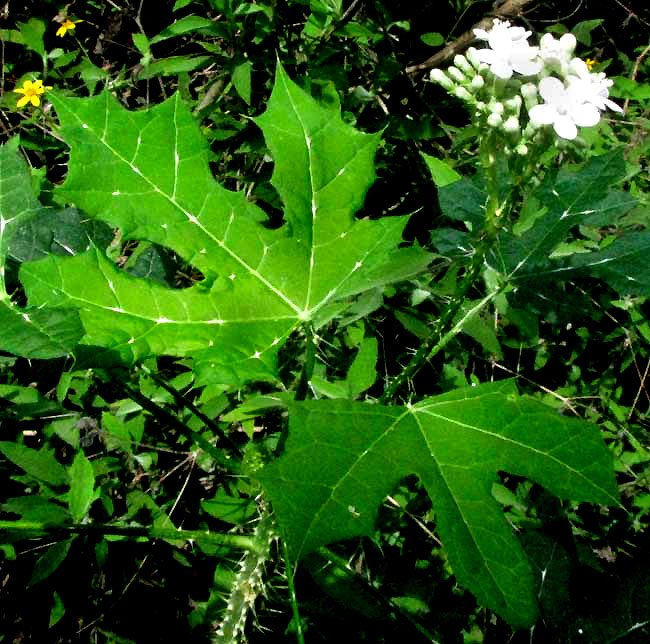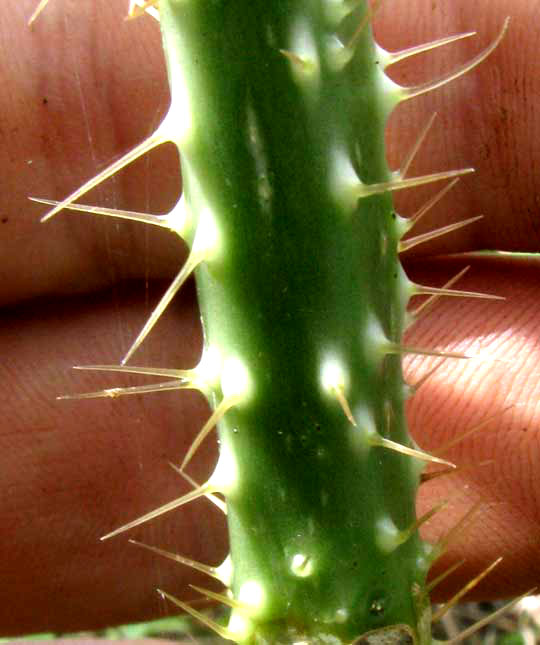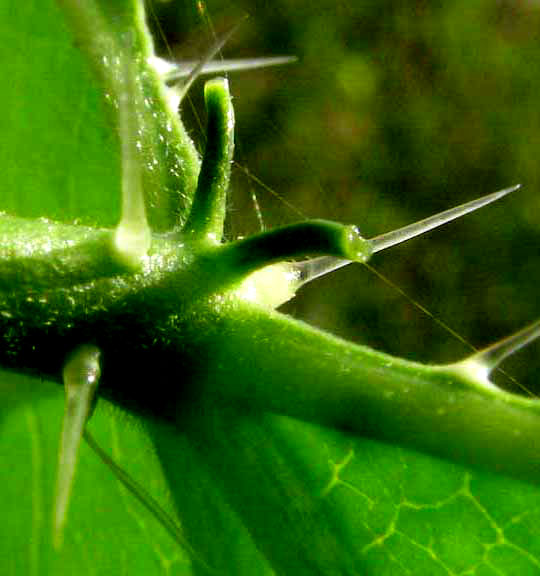Excerpts from Jim Conrad's
Naturalist Newsletter

from the February 6, 2012 Newsletter issued from Hacienda Chichen Resort beside Chichén Itzá Ruins; limestone bedrock; elevation ~39m (~128ft), N20.675°, W88.569°; central Yucatán state, MÉXICO
MALA MUJER #2
At www.backyardnature.net/yucatan/malamujr.htm I've already introduced you to the wonderplant Chaya, which produces edible leaves high in protein content along with lots of vitamins and minerals, and which is an important planted shrub around most traditional Maya homes. Chaya is the domesticated form of a common native bush or small tree found here throughout the forest, and known in Spanish as Mala Mujer, or "Bad Woman."
The plant is "bad" because it abundantly bears many stiff, sharp, stinging hairs of the kind Northern nettles have, except much larger and more painful to make contact with. I don't know why the name givers made it a woman instead of a man, for it seems to me that men are more likely to be prickly than women.
Whatever the gender issues, it took me awhile to realize that in our local forest there were two, not one, very closely related species of "Mala Mujer" that most people, including the Maya I know, don't differentiate. You can see how very similar they are by comparing the leaves and flowers of the Mala Mujer we've already seen, at the top of page linked to above, with a similar shot of our second species shown at the top of this page.
The species we've already looked at, which includes both the wild, very spiny Mala Mujer and its almost-spineless, edible domesticated form, is Cnidoscolus aconitifolius. Our second species it took me a while to recognize is CNIDOSCOLUS SOUZAE, which is endemic just to the Yucatan Peninsula.
My impression is that Cnidoscolus souzae is even a little spinier than the Wild Chaya one. You can see the stinging spines on a young bush's trunk below:

Once you know the secret, it's easy to distinguish the two species. Unlike with most closely related species, the difference is vegetative, not with flowers or fruits. The secret field mark is that the glands atop each leaf's petiole at the point of attachment with the blade are very different. First you might want to look at the glands atop a Wild Chaya's petiole at www.backyardnature.net/n/10/100801co.jpg.
Compare that with the same gland location on a C. souzae below:

One wonders why the wisdom of evolution chose to provide two very similar species with such different glands. A good guess is that the glands must be extraordinarily important to the plants, or at least were at some point in their evolutionary history. Since the leaves are so highly edible, another good guess is that the glands, like the stinging hairs, protect against leaf-eating animals. Usually such glands either repel with disagreeable chemicals, or attract ants who bite grazing herbivores.
The free, online, Spanish-language Biblioteca Digital de La Medicina Tradicional Mexicana says that to relieve rheumatism you should rub the leaves or beat the stems of this species on rheumatic joints. Since both leaves and stems are heavily armored with stinging hairs, this is similar to having honeybees sting affected joints. I've seen the Maya collecting bees for that.